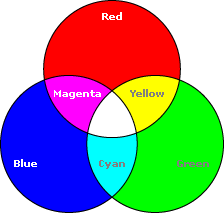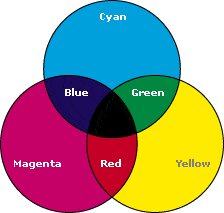|
|
Two
Kinds of Color |
 |
|
|
|
|
|
|
Color Models
A color model is an orderly system for creating a whole
range of colors from a small set of primary colors.
There are two types of color models, those that are
subtractive and those that are additive.
Additive color models use light to display color
while subtractive models use printing inks. Colors
perceived in additive models are the result of transmitted
light. Colors perceived in subtractive models are the
result of reflected light.
The Two Most Common Color
Models
There are several established color models used in
computer graphics, but the two most common are the RGB
model (Red-Green-Blue) for computer display and the
CMYK model (Cyan-Magenta-Yellow-blacK) for printing.
RGB Color Model
Additive color model
For computer displays
Uses light to display color
Colors result from transmitted light
Red+Green+Blue=White
 |
CMYK Color Model
Subtractive color model
For printed material
Uses ink to display color
Colors result from reflected light
Cyan+Magenta+Yellow=Black
 |
Notice the centers of the two color charts. In the
RGB model, the convergence of the three primary additive
colors produces white. In the CMYK model, the convergence
of the three primary subtractive colors produces black.
In the RGB model notice that the overlapping of additive
colors (red, green and blue) results in subtractive
colors (cyan, magenta and yellow). In the CMYK model
notice that the overlapping of subtractive colors (cyan,
magenta and yellow) results in additive colors (red,
green and blue).
Also notice that the colors in the RGB model are much
brighter than the colors in the CMYK model. It is possible
to attain a much larger percentage of the visible spectrum
with the RGB model. That is because the RGB model uses
transmitted light while the CMYK model uses reflected
light. The muted appearance of the CMYK model demonstrates
the limitation of printing inks and the nature of reflected
light. The colors in this chart appear muted because
they are displayed within their printable gamut (see
below).
Additive vs. Subtractive Color Models
Since additive color models display color as a result
of light being transmitted (added) the total absence
of light would be perceived as black. Subtractive
color models display color as a result of light being
absorbed (subtracted) by the printing inks. As more
ink is added, less and less light is reflected. Where
there is a total absence of ink the resulting light
being reflected (from a white surface) would be perceived
as white.
Color Gamut and Color "Space"
Each color model has is own gamut (range) of colors
that can be displayed or printed. Each color model is
limited to only a portion of the visible spectrum. Since
a color model has a particular range of available color
or gamut, it is referred to as using a "color space".
An image or vector graphic is said to use either the
RGB color space or the CMYK color space (or the color
space of another color model). Some graphic applications
present the user with more than one color model for
image editing or illustration and it is important to
choose the right one for the task. The whole point of
this article is to explain the difference between the
two color models so you choose the right one for the
job. For you work to display at its best, choosing the
right color model is critical.
RGB Color
The RGB model forms its gamut from the primary additive
colors of red, green and blue. When red, green and blue
light is combined it forms white. Computers generally
display RGB using 24-bit color. In the 24-bit RGB color
model there are 256 variations for each of the additive
colors of red, green and blue. Therefore there are 16,777,216
possible colors (256 reds x 256 greens x 256 blues)
in the 24-bit RGB color model.
In the RGB color model, colors are represented by varying
intensities of red, green and blue light. The intensity
of each of the red, green and blue components are represented
on a scale from 0 to 255 with 0 being the least intensity
(no light emitted) to 255 (maximum intensity). For example
in the above RGB chart the magenta color would be R=255
G=0 B=255. Black would be R=0 G=0 B=0 (a total absence
of light).
CMYK or "Process
Color"
The CMYK printing method is also known as "four-color
process" or simply "process" color. All
of the colors in the printable portion of the color
spectrum can be achieved by overlapping "tints"
of cyan, magenta, yellow and black inks. A tint is a
screen of tiny dots appearing as a percentage of a solid
color. When various tints of the four colors are printed
in overlapping patterns it gives the illusion of continuous
tones - like a photograph:
| The
CMYK model forms its gamut from the primary subtractive
colors of cyan, magenta and yellow. When cyan, magenta
and yellow inks are combined it forms black - in
theory. However, because of the impurities in ink,
when cyan, magenta and yellow inks are combined
it produces a muddy brown color. Black ink is added
to this system to compensate for these impurities.
|
|
 |
In the CMYK color model, colors are represented as
percentages of cyan, magenta, yellow and black. For
example in the above CMYK chart the red color is composed
of 14% cyan, 100% magenta, 99% yellow and 3% black.
White would be 0% cyan, 0% magenta, 0% yellow and 0%
black (a total absence of ink on white paper).
When In Doubt, Save Images As RGB
The RGB model displays a much larger percentage of
the visible spectrum than the CMYK model and, as a result,
has a wider gamut. Once an image has been converted
from RGB to CMYK and brought into printable gamut, the
extra RGB data will be lost.
One can retain out-of-gamut areas in CMYK images and
leave it to the computer to bring the colors into gamut
at printing time. However this requires the computer
to make the conversion from RGB to CMYK and this doesn't
always work out as well as one might expect. Conversion
between color models is not always a good idea.
Because of this fact, you want to scan or shoot images
(with a digital camera) using the appropriate color
model for their primary purpose. If the images will
be used primarily for print then use CMYK. If they will
be used primarily for screen displays, then use RGB.
You can always convert from RGB to CMYK (or vise-versa)
but it is best not to.
If you can afford the time, money and disk space to
scan or shoot both versions of an image where both are
needed, then this is the best solution. This is especially
true if you will be using the same images for both printed
material (such as a catalog) and the web (such as an
online catalog). A little planning can go a long way
here.
But if you are not sure, then I generally recommend
saving images in RGB mode and creating CMYK copies for
printed material as needed.
Use RGB For Screen Displays and CMYK For Print
It is important to choose the right color model for
the job. If your images will be printed, then convert
them to CMYK and manually bring them into gamut before
printing. If your images are to be displayed on a computer,
then make sure you use RGB color so the full gamut will
be available for display. Because both models can be
available at the same time while using an application,
it is easy to make a mistake and choose the wrong palette
or set of color swatches.
Click
Here To Continue...
|